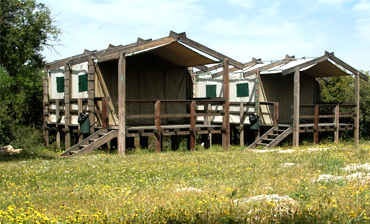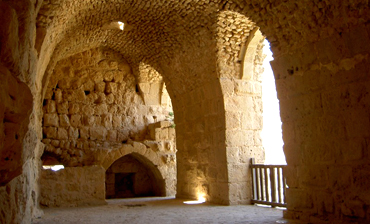73 km north of Amman, and a short journey northwest from Jerash, through a beautiful pine-forest and olive groves, brings you to the town of Ajloun, where Hadrian stayed over the winter of 129-30 AD, and built himself an arch well outside the town, leaving unbonded its sides for future city walls to come out to meet it.
Here you will find the Castle of Ajloun or Qalaat Errabadh (Arabic for "Hilltop Castle"), from which there is a splendid view westwards into the Jordan Valley. It looks like a Crusader fortress, but it was built by Muslims in 1184-85 as a military fort and buffer to protect the region from invading Crusader forces. It was built on the orders of the local governor, Ezz Eddin Osama bin Munqethe, a nephew of the Ayyubid leader Salahuddin Al-Ayyoubi (Saladin), as a direct retort to the new Latin castle of Belvoir (Kawkab El-Hawa) on the opposite side of the valley between the Tiberias and Besan, and as a base to develop and control the iron mines of Ajloun.



This superb example of Arab and Islamic architecture was built as a rectangle with four square towers and an entrance on the south side dominating a wide stretch of the north Jordan Valley and passages to it. From its hilltop position, the Castle of Ajloun protected the communication routes between south Jordan and Syria, and was one of a chain of forts, which lit beacons at night to pass signals from the Euphrates as far as Cairo.
Two years after it was completed the fortress's original purpose had already been outlived, for Salahuddin defeated the Crusaders at the battle of the Horns of Hattin in 1189, which marked the beginning of the end of their occupation of the Holy Land.
In 1214-15 the Castle of Ajloun was enlarged by Aybak bin Abdullah, majordomo of the Caliph Al-Muazham Isa; in 1260 it fell to the Mongols, but was later rebuilt by the Egyptian Mamluks. No longer needed for military purposes, it was used as an administrative center responsible to Damascus.
Some of the stones with which the castle was built have crosses carved into them, giving credence to a tradition, recounted by a 13th century Arab historian that: "an ancient monastery once stood on the site, inhabited by a Christian named Ajloun; when the monastery fell into ruin, the castle took its place and the name of the monk".
The castle today is beautifully preserved and is a popular attraction for foreigners & Jordanians alike. The structures, towers, chambers, galleries and staircases that form part of the town as well as the beautiful scenery that surrounds the hills nearby will captivate you.
Ajlun is just a short journey from Jerash through pine forest and olive groves and boasts scores of ancient sites, including watermills, forts and villages, all in the beautiful hills and valleys of northern Jordan.
OUR ADDRESS
Mecca St., Building #164
947589 Amman 11194 Jordan
CALL US
+962 6 551 6251
+962 79 52 666 33
EMAIL US
info@jordan-holidays.com